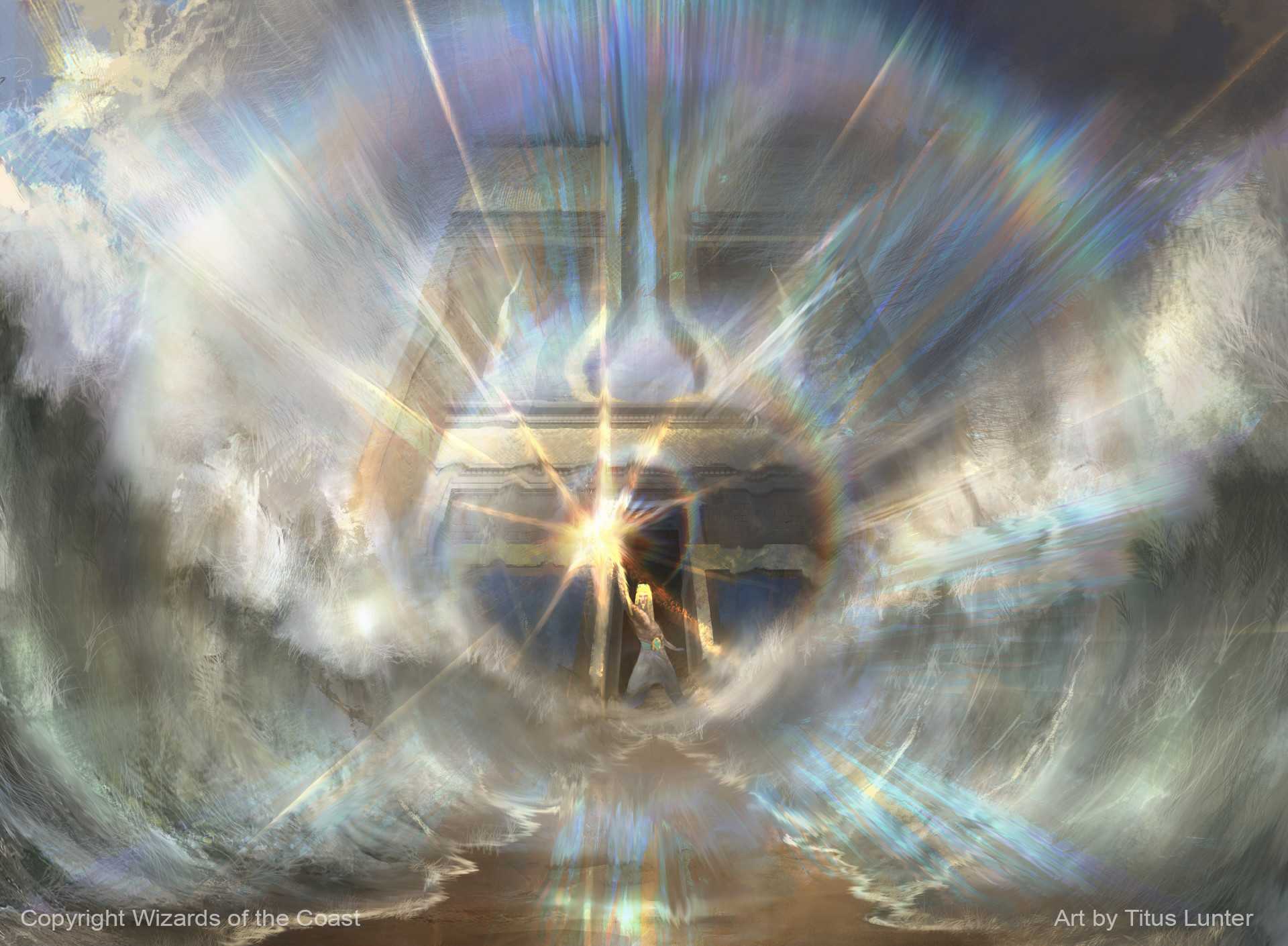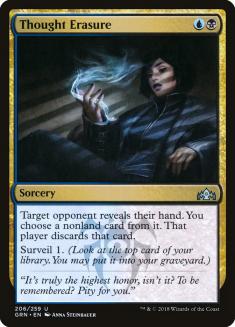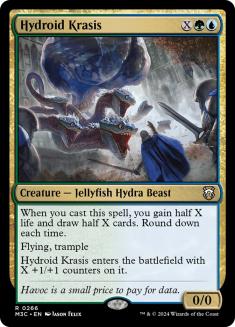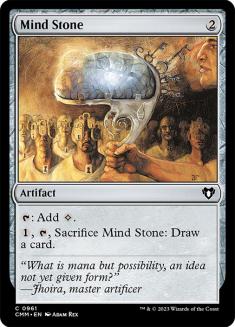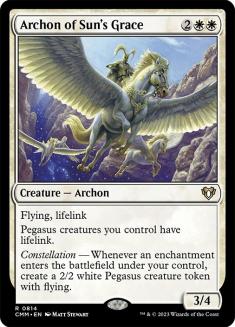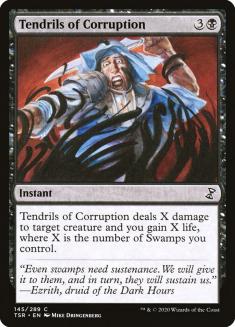Pact of Negation is the most interesting card in Historic for me at the moment. In the past, I’ve generally used Pact of Negation in spots where I’m planning to kill my opponent and I just want to make sure they can’t do anything about it, with no real intention of ever paying 3UU. Historic is a format where I think playing Pact of Negation “as intended” can really shine.
The last few years have featured an above-average number of five-mana cards that take over the game if you untap with them. Instead of Thragtusk and Acidic Slime, we have Teferi, Hero of Dominaria and Nissa, Who Shakes the World.
Every turn that you can have one of these cards on the battlefield generates so much value that there’s a huge demand for “buy now, pay later,” and Pact of Negation really shines when the game revolves around both players casting five-mana spells.
I’ve been experimenting with Pact of Negation following Field of the Dead’s ban, and I’ve run into a lot of scenarios where something happens like I tap out for Elder Gargaroth and my Gruul opponent attacks with everything and casts Embercleave. I Pact the Embercleave and immediately reverse a loss into a win. Or I cast Teferi, Hero of Dominaria in a control mirror, they cast Neutralize, I force it through with Pact of Negation, and they immediately concede.
These turns when you can double-spell are what games hinge on, and when the two spells are your own five-mana spell and countering their five-mana spell, you’ve basically taken a full extra turn, which is more than people can generally recover from in a format where each turn is this high-impact.
The worst case for Pact of Negation is that you play against a deck where all their spells are cheap, but even against Azorius Auras (Lurrus), I’ve found that I often end up in a spot where I’m going to cast a sweeper and they’re intending to recover by casting Lurrus of the Dream-Den and something from their graveyard, and I Pact the Lurrus and they’re out of gas.
That said, it can often be too slow for those matchups. It’s blank until you have five mana, but if you build a deck with with a normal curve for Historic and then think of yourself as playing Pact of Negation “as your five-drop,” you have the problem that your five-mana spell doesn’t actually win the game when you cast it. This means that if you’re going to play with it, you’re probably going to have a curve that’s a little too high — you have to balance the threat of not having enough to do in the early-game against the risk of not having enough actual closing power.
Pact of Negation wants to be played alongside proactive five-mana spells that it can protect, so you want a reasonable density of expensive spells and you also definitely want enough mana in your deck that you’ll always hit your fifth mana on time. That mana eats into spell slots, so now you have even less room to work with for your early-game, so building around Pact of Negation is a bit of a deckbuilding puzzle.
So how do we solve this puzzle? Well, I mean, the easiest way is with Uro, Titan of Nature’s Wrath, obviously. We need to hit five mana ahead of schedule and have plenty of gas, where else could that possibly lead?
I’m very thoroughly on Team Unprint Uro, largely because it’s just miles ahead of any other solution to this kind of problem in a way that makes everything less interesting, but also because I think there’s a chance that Historic could follow Standard’s lead and become entirely dominated by Sultai Midrange.
It’s probably time to get to some decks rather than another rant about Uro. After starting out with something more controlling, I realized that the format still demands proactivity, and my current Sultai Pact deck looks like this:
Creatures (12)
Planeswalkers (3)
Lands (27)
Spells (18)
Sideboard

This is still a work in progress, but the basic pairing of Thoughtsieze to slow the early-game, Growth Spiral and Uro to ramp, and then powerful five-mana spells to cast on Turn 4 with Pact protection is a good baseline.
Thought Erasure feels better than removal in the maindeck at the moment, since even against creature decks it lines up better against cards like Collected Company; Bolas’s Citadel; and Muxus, Goblin Grandee, and it also means you’re much better against noncreature decks. The sideboard has a lot of creature removal to make up for the fact that there’s none in the maindeck.
This could probably use a couple of versatile answers like Maelstrom Pulse somewhere, and I’m not sure if Disfigure is a better cheap removal spell than Innocent Blood.
The exact mix of five-mana spells and Hydroid Krasis is very much up in the air, I’m not totally sold on Cultivate or the exact land count, and it’s possible I’d want to go back down to six discard spells instead of eight, but this deck has felt powerful and well-rounded.
One thing playing this deck really highlighted was the strength of casting a big Krasis that can draw into Pact of Negation, and I think Pact of Negation can be expected to similarly improve other draw-X spells, like Sphinx’s Revelation, Finale of Revelation, and Explosion.
So my baseline at the moment for where to use Pact of Negation in Historic is, “It should probably be played in every deck with Uro,” and I think I believe that statement.
Beyond that, I think it does have other applications. It’s harder to use outside of green because I don’t really think you want to wait until after your fifth turn to be able to cast it at the earliest (though I could imagine it rounding out a Grixis Control deck with no acceleration), but I think Azorius with Mind Stone is another good home for it.
As with Field of the Dead decks, Wrath of God is a great tool for decks that have to play a little too much mana to catch up on both cards and tempo, and Pact of Negation can pair with it to counteract the classic aggro strategy of “make them tap out for a sweeper, resolve something big” (if you can afford to wait to cast Wrath of God). Wrath of God is also particularly appealing in Historic because cheap spot removal in the format generally feels particularly below rate.
I put some work into Azorius Control, but I wasn’t really happy with it, and I don’t think it’s an archetype I build especially well. The biggest deal breaker for me was that it handled haste out of Goblins and Gruul so poorly, and I’m not sure what the solution to that is, but here’s where I left off:
Planeswalkers (2)
Lands (27)
Spells (31)

I’d previously tried to use Frantic Inventory and Rain of Revelation, but I think I prefer Thirst for Meaning and Omen of the Sea, thanks to picking up Shark Typhoon as an additional enchantment.
Archon of Sun’s Grace is an attempt to solve the haste problem proactively, which I think is the right idea. I’m not sure that Archon specifically is the exact right threat, but I think it probably is. I think I want a few more enchantments total; it’s possible that The Birth of Meletis maindeck is the solution, or maybe Runed Halo or Seal Away. I’m also not sure about Seal Away versus Baffling End in the sideboard. I could also just see playing more copies of Search for Azcanta. Elspeth Conquers Death is also on the table, though I think it’s better in the sideboard.
Sphinx’s Revelation mostly felt a little on the clunky side, and might be worse than playing more planeswalkers.
It’s really hard for me to design a deck that wants to have access to 3UU reliably that doesn’t loop back around to Uro as the best way to get there with Thoughtseize as the best way to lead to small games that Uro best dominates. The most reasonable alternatives I can think of are nongreen ramp and noninteractive ramp.
By nongreen ramp I mean decks like Mono-Blue Devotion with Nyx Lotus and Mono-Black Control with Chromatic Lantern. Pact of Negation is an awesome card to be able to Wish or Tutor for when you’re ahead, so I can see it playing really well in a Fae of Wishes or Mastermind’s Acquisition deck.
By noninteractive ramp I mean decks that are so focused on ramping that they don’t want to cast spells to slow the game down and fill their graveyard, so Uro’s not really at its best.
Creatures (5)
Planeswalkers (2)
Lands (25)
Spells (28)

I love Tendrils of Corruption, which makes this deck weirdly appealing to me even if I don’t think it looks especially strong.
This deck has been around for awhile, and the addition of Thoughtseize should help it quite a bit. This deck generally plays from behind and uses Mastermind’s Acquisition to find something to turn the game around or win outright rather than to seal an advantage, which means I don’t think Pact of Negation would be an especially common thing to grab, but I do think it fills a unique enough role to justify a sideboard slot.
Creatures (27)
- 4 Llanowar Elves
- 3 Ulamog, the Ceaseless Hunger
- 4 Incubation Druid
- 4 Paradise Druid
- 4 Gilded Goose
- 2 Fae of Wishes
- 2 Kinnan, Bonder Prodigy
- 4 Llanowar Visionary
Planeswalkers (4)
Lands (22)
Spells (7)

This is the kind of ramp deck where Uro really doesn’t shine; you could potentially play one to strengthen your late-game, but the low land count and lack of cards that fill the graveyard make it a bad fit overall. However, this deck can really benefit from Pact of Negation, as it can help insulate you from the vulnerability to sweepers caused by relying on creatures for mana.
At the end of the day, it’s really starting to feel like designing a deck without Uro that isn’t just trying to kill the opponent through aggression like Azorius Auras or a combo finish like Bolas’s Citadel is just wishful thinking, but as we work to figure out exactly how Uro will dominate Historic, I think Pact of Negation will grow to become an important piece of that puzzle.

